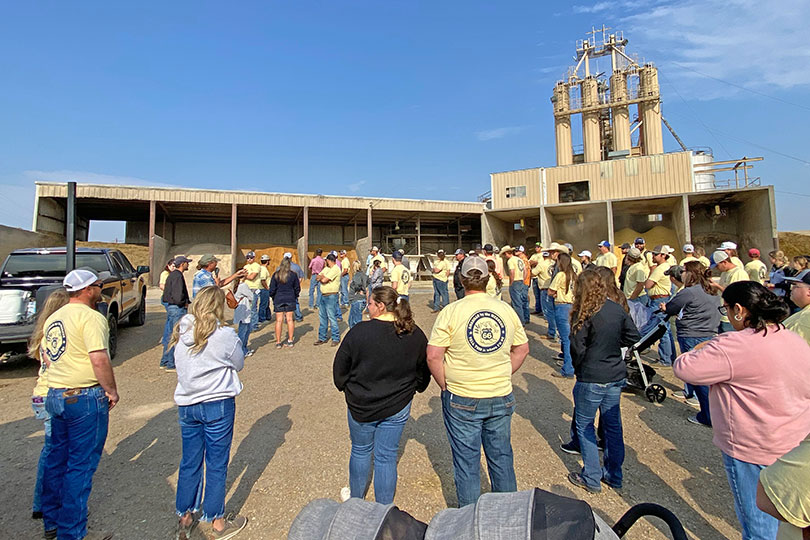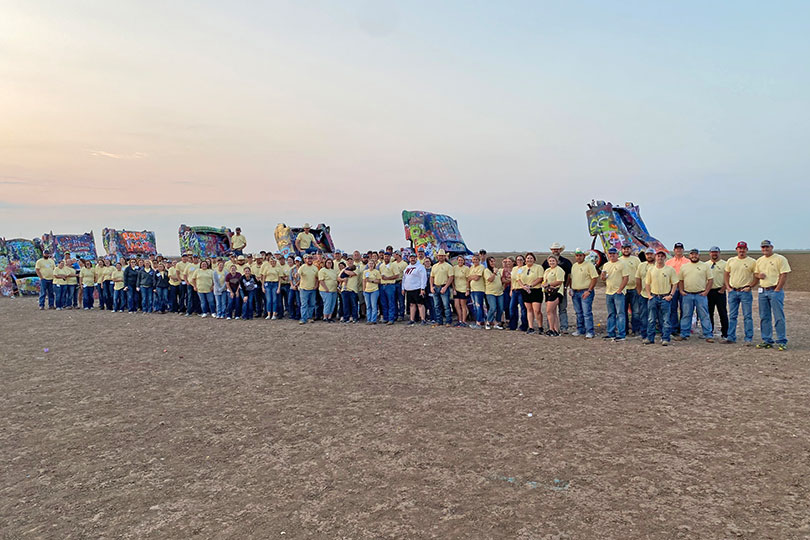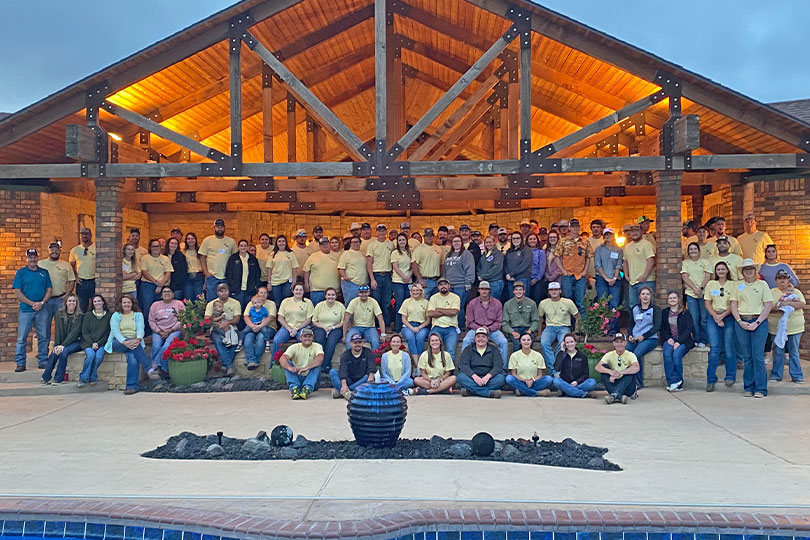By Julie Tomascik
Editor
A look at farms, feedyards, a cotton gin and more were part of the 2022 Texas Farm Bureau (TFB) Young Farmer & Rancher (YF&R) Fall Tour held in the Panhandle.
The two-day event exposes young farmers, ranchers, college students and agricultural professionals to agriculture in a different region of the Lone Star State each year.
“It’s important for people across the state in agriculture to know how different and diverse agriculture is in Texas,” said Landon Friemel, TFB YF&R Advisory Committee member for District 1. “If you look at Texas as a whole, agriculture changes dramatically between the Panhandle and the southern tip of the state and also from the east side of the state to the west. The scope of which us as producers encompass—you can’t really understand it without seeing it.”
This year’s tour included stops in and around Amarillo.
At Top of Texas Gin, the group toured a cotton gin that wasn’t currently in operation.
“We were able to look around the machines and see how a cotton gin works,” Friemel said.
Cotton is an economic driver in the region. Although this year’s crop is significantly smaller, the largest cotton patch in the U.S. is the area surrounding Lubbock.
“We talked about how cotton yields are a lot lower this year than in year’s past,” he said. “We also discussed cotton markets, buyers and more on this stop.”
At West Texas A&M University (WTAMU), Fall Tour participants heard from the university’s collegiate Farm Bureau chapter and toured the new agricultural complex.
“There’s so much that WT has done in improving ag education, whether it be for ag teachers, ag science or ag business,” Friemel said. “We did get to see the new meat facility in operation and visited with Collegiate Farm Bureau members to see what they have going on this semester.”
WTAMU chartered the first collegiate Farm Bureau chapter in Texas last year.
Students in the organization are members of a Farm Bureau family. Some are from out of state, and they represent diverse backgrounds and college majors, including agricultural business, animal science, agricultural education and agricultural communications, among others.

“The collegiate officer team shared more about how they started the organization and how their program is growing exponentially,” Friemel said. “They told us they are one of the largest student organizations on campus. I think it’s just amazing to see that.”
Another tour stop included Cnossen Dairy.
“The Cnossen family is investing in new infrastructure and expanding their herd. They are also going into different avenues other than just the traditional Holstein. They’re moving out into Jerseys, and they’re trying to target different markets,” he said.
Tour participants saw the impressive machinery, technology and carousel in action, learning more about dairy production in the Texas Panhandle.
“They can manage those cows on an individual cow basis using the technology and RFID readers, the sort gates and so many different things they can do. It’s very impressive,” he said.
Across the road from the dairy is Friemel’s family’s feedyard.
“We currently have about 25,000 head on feed. I was able to take the attendees on a tour of the feed mill, show them the feeding process, talk about where our cattle are from and what markets we’re targeting,” he said. “I think a large portion of our group got a lot out of that information because there were a lot of cow-calf producers there, as well as people trying to start their own small feeding operation.”
They discussed cattle markets, supply chain issues and rising feed costs.
“It’s been a tough couple of years because of those factors,” he said. “Numbers are increasing in the feedyard because there’s not enough grass, but it’s also costing a lot more to feed them because the cost of grain is going up.”
They also visited the Vega High School ag shop where members of the Vega FFA cooked lunch for the group.
Jay Newton, Vega High School ag teacher, shared with the group the success and growth of the high school’s agricultural science and FFA programs.
Vega FFA is most known for its success in the ag mechanics contests at stock shows across the state. In fact, the Vega FFA Ag Mechanics program has surpassed $1 million in scholarships and prizes awarded to students who have participated and competed in the contests.
“There’s so many skills and qualities that this ag mechanics program can give students to help them later on in life and in their future careers,” Friemel said.
One of the final tour stops was Richardson Seeds, which is a sorghum breeding production and packaging company.
“Most people don’t realize that 85-90% of the world’s sorghum seed is produced in the Texas Panhandle, and Richardson Seeds is one of about five companies that take care of that entire process from the genetics and breeding to bagged product shipped all over the world.”
They visited Maverick Malt House in Wildorado.
“They take barley and rye growing on their family farms and turn it into a malt product that’s used in the production of whiskey and beer,” Friemel said. “It’s a state-of-the-art facility where they can control every aspect regarding temperature, moisture, timers for agitation and all the details that can change the flavor of their product.”
Other fun activities on the tour included watching an Amarillo Sod Poodles baseball game and visiting Cadillac Ranch, a well-known tour stop along Route 66 west of Amarillo.
The trip gave young farmers and ranchers a look at Panhandle agriculture, a chance to network and learn techniques to adopt on their farms and ranches.
“It’s the contacts that you make and the friends that you meet,” Friemel said. “When you can meet somebody from the other side of the state that does things differently, there’s ideas that we can share, and we can learn from each other to make our operations better.”


